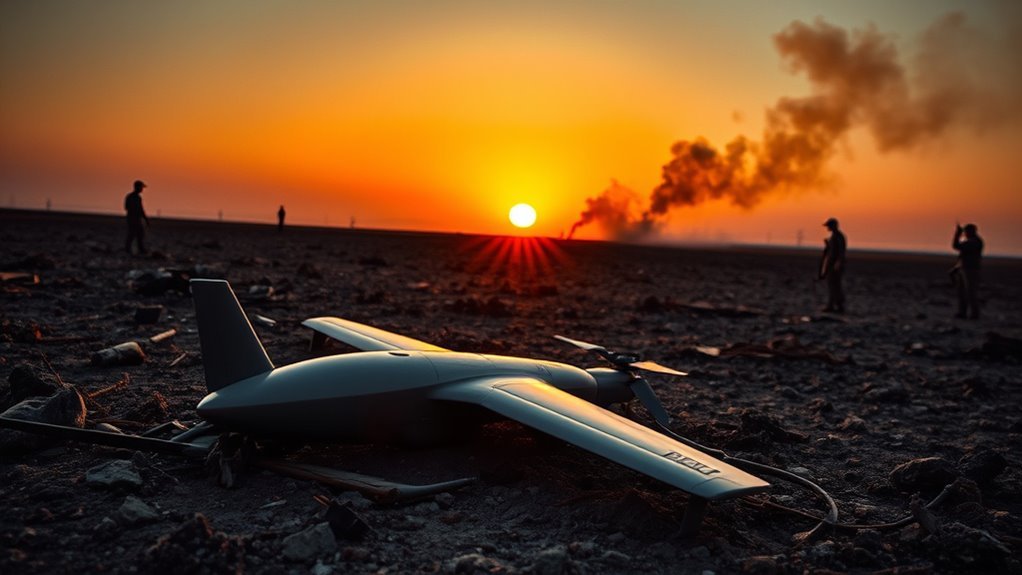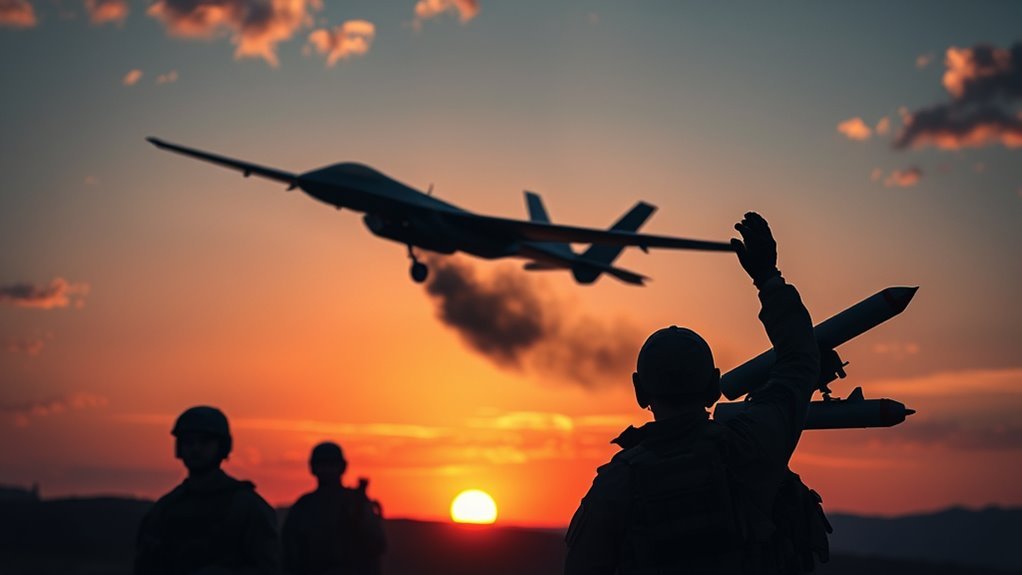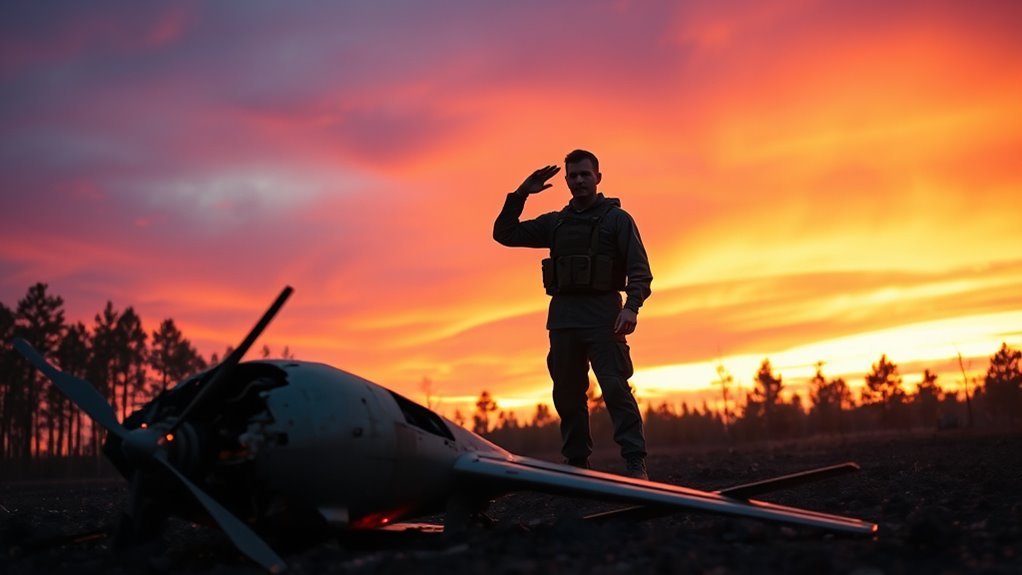In 2019, Iran shot down a U.S. drone over the Strait of Hormuz, escalating tensions markedly. Turkey’s quick responses to Syrian drones showcase its commitment to national security. Ukraine successfully downed a Russian drone, highlighting modern warfare’s intensity. Israel focuses on intercepting Hamas drones, evolving its defense strategies. Finally, the U.S. faced challenges with drone incidents in Afghanistan, prompting tactical reassessments. If you want to explore these incidents further, there are more insights to uncover.
The Downing of a US Drone by Iran in 2019

In June 2019, as tensions between the U.S. and Iran escalated, a U.S. military drone was shot down over the Strait of Hormuz, marking a significant moment in the ongoing conflict between the two nations. This incident not only showcased Iran’s growing capabilities in drone technology but also highlighted the fragile state of international relations. As you analyze the implications, consider how this act intensified existing Iran tensions, prompting a series of retaliatory measures and heightened military readiness. The downing of the drone raised questions about the effectiveness of U.S. surveillance operations and the potential for further escalation in the region. Ultimately, it underscored the delicate balance of power and the risks associated with advanced military technologies in volatile environments.
Turkey’s Military Response to Syrian Drones

The complexities of drone warfare extend beyond the U.S.-Iran tensions, as Turkey has also been actively responding to threats posed by Syrian drones. Turkey’s drone strategy emphasizes quick and strategic responses to violations in Syrian airspace, which they deem a direct threat. By deploying advanced drones and anti-drone systems, Turkey aims to assert its dominance and protect its borders. You’ll notice that these actions serve not only as a military response but also as a show of strength in a region fraught with instability. Turkey’s proactive measures highlight its commitment to national security while maneuvering the intricate web of alliances and conflicts in the Middle East. As tensions rise, the effectiveness of Turkey’s drone strategy will be vital in maintaining its regional influence.
The Shootdown of a Russian Drone by Ukraine

While tensions between Ukraine and Russia continue to escalate, recent reports of Ukraine successfully shooting down a Russian drone underscore the ongoing air conflict’s intensity. This incident highlights the critical role of UAV technology in modern warfare. By effectively utilizing advanced detection systems and counter-drone tactics, Ukraine demonstrates its commitment to defending its sovereignty. The shootdown reflects a significant shift in military strategy, where both nations increasingly rely on drones for reconnaissance and targeting. As you observe this aerial battle, it’s clear that Ukraine’s proactive measures not only disrupt Russian operations but also empower its forces. Such actions reinforce the importance of technological innovation and strategic adaptability in the pursuit of freedom and national security.
Israel’s Targeting of Hamas Drones
As aerial warfare evolves, Israel’s focus on targeting Hamas drones illustrates the broader implications of drone technology in regional conflicts. You’ll see how Hamas employs innovative drone strategies to bypass traditional defenses, often launching reconnaissance and attack missions. In response, Israeli air defenses have been considerably upgraded, incorporating advanced systems like the Iron Dome to neutralize these aerial threats. The ongoing cat-and-mouse game between Hamas and Israel highlights the necessity for vigilance and adaptability in military tactics. Each intercepted drone not only protects civilians but also serves as a reminder of the shifting dynamics in warfare. Understanding these developments is essential for grasping the complexities of freedom and security in the region, as both sides continue to evolve their aerial capabilities.
US Military Engagements in Drone Incidents in Afghanistan
In the complex landscape of military operations, the U.S. has increasingly relied on drone technology to conduct precise strikes and gather intelligence in Afghanistan. Afghanistan drone surveillance has become a cornerstone of US military strategies, allowing for real-time monitoring of enemy movements and potential threats. However, this reliance hasn’t been without setbacks. Instances of drones being shot down—either by enemy fire or technical failures—have raised concerns about operational security and the effectiveness of these aerial assets. Each incident reveals vulnerabilities in US military engagements, prompting a reassessment of tactics and technology. As the landscape evolves, understanding these drone incidents is crucial for maintaining freedom and ensuring the safety of both military personnel and civilians in conflict zones.
Frequently Asked Questions
What Technologies Are Used to Detect and Shoot Down Drones?
“Where there’s smoke, there’s fire.” To detect drones, you’ll find radar, radio frequency, and infrared technologies. Anti-drone technologies, including jammers and laser systems, help mitigate unauthorized aerial intrusions, ensuring safety and freedom in your surroundings.
How Do Drones Impact Modern Warfare Strategies?
Drones considerably shape modern warfare strategies by enhancing drone surveillance capabilities and enabling real-time intelligence. Their integration marks a warfare evolution, allowing for more precise operations while minimizing risks to personnel, consequently redefining military engagements.
What Legal Implications Arise From Shooting Down Drones?
When you gaze at the sky, consider drone legality and airspace regulations. Shooting down a drone can ignite legal battles over rights and sovereignty, challenging your sense of freedom and complicating modern aerial governance.
How Do Countries Investigate Drone Shootdowns?
When countries investigate drone shootdowns, they follow specific investigation protocols, focusing on drone identification. They analyze flight paths, ownership, and intent, ensuring transparency while balancing national security and the public’s desire for accountability and freedom.
What Are the Potential Consequences of Escalating Drone Conflicts?
As tensions rise like a storm, escalating drone conflicts could fracture international relations, leading to miscalculations, retaliatory strikes, and broader military engagements. You need to grasp these dynamics to understand the fragile balance of global peace.

